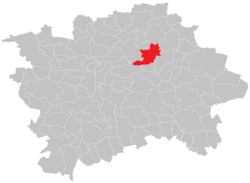Vysočany (German: Wissotschan) is a part of Prague in the Prague 9 administrative district (partly in Prague 3), Czech Republic. It lays in the eastern part of Prague around the valley with Rokytka river.
Vysočany
Wissotschan (German) | |
|---|---|
District of Prague Administrative District of Prague | |
 Prague 9 town hall in Vysočany | |
 Praha KÚ Vysočany.png | |
| Coordinates: 50°6′38″N 14°30′0″E / 50.11056°N 14.50000°E | |
| Country | Czech Republic |
| Region | Prague |
| Area | |
| • Total | 6.06 km2 (2.34 sq mi) |
| Population (2011) | |
| • Total | 15,214 |
| • Density | 2,500/km2 (6,500/sq mi) |
| Time zone | UTC+1 (CET) |
| • Summer (DST) | UTC+2 (CEST) |
| Postal code | 190 00 |
| Website | http://www.praha9.cz |
| Year | Pop. | ±% |
|---|---|---|
| 1869 | 1,766 | — |
| 1880 | 2,334 | +32.2% |
| 1890 | 3,329 | +42.6% |
| 1900 | 4,406 | +32.4% |
| 1910 | 6,896 | +56.5% |
| 1921 | 8,554 | +24.0% |
| 1930 | 15,762 | +84.3% |
| 1950 | 18,207 | +15.5% |
| 1961 | 17,202 | −5.5% |
| 1970 | 13,005 | −24.4% |
| 1980 | 10,340 | −20.5% |
| 1991 | 8,197 | −20.7% |
| 2001 | 8,013 | −2.2% |
| 2011 | 15,214 | +89.9% |
| 2021 | 17,465 | +14.8% |
| Source: Censuses[1][2] | ||
History
edit- The first recorded information about Vysočany is from 1115 when the duke Vladislav I. gave Vysočany vineyards to Kladruby monastery.
- In 1896 - Emil Kolben - important Czech engineer and entrepreneur (former employee and friend of Thomas Edison) founded its factory which later became famous ČKD. This strongly influenced Vysočany as a heavily industrial district of Prague.
- In the year 1902 - the emperor Franz Joseph I of Austria awarded Vysočany with the title of city and the right to use its coat of arms.
- 1911 - Vysočany Town Hall was built
- In 1922 - Vysočany became part of Prague.
- In 1939 - after Nazi invasion of Prague. The majority of industrial production had to be refocused on military production to support Nazi-Germany war
- In 1942 - several families from Vysočany were involved in the Operation Anthropoid (assassination of Reinhard Heydrich)
- In 1945 - during the end of World War II the district was heavily damaged during the Bombing of Prague. The targets were factories which were forced to produce military material.
- In 1968 - after the invasion of Russian armies - there was a special convention of the Czechoslovak Communist Party held in Vysočany which strongly condemned the invasion of the Soviet armies.
- Since 1990s - the new era after Velvet Revolution saw Vysočany transforming from heavily industrial district to new modern residential part of Prague. Big part of construction is focused on the "brown-fields" after former factories.
Infrastructure
edit- Vysočany has 2 metro stations on the line B: Vysočanská and Kolbenova.
- 2 train stations (Praha-Vysočany and Praha-Libeň).
- The oldest airport in Prague Kbely lies partly in Vysočany.
Interesting facts
edit- The tallest residential building in the Czech Republic Rezidence Eliška is in Vysočany.
- Vineyard Máchalka is the only one left in the almost 1000-year history of vine production in Vysočany. It was renewed in 1998.
- Part of the Pragovka factory was rebuilt to an artist/community center
- The largest flea market in Prague is in Vysočany district in the U Elektry street.
- O2 Arena (Prague) with the shopping mall Galerie Harfa and Harfa Business District is generally considered as Vysočany although officially lies in Libeň district.
References
edit- ^ "Historický lexikon obcí České republiky 1869–2011 – Praha" (in Czech). Czech Statistical Office. 2015-12-21.
- ^ "Výsledky sčítání 2021 - otevřená data". Public Database. Czech Statistical Office. 2021-03-27.
External links
editWikimedia Commons has media related to Vinohrady (Prague).
